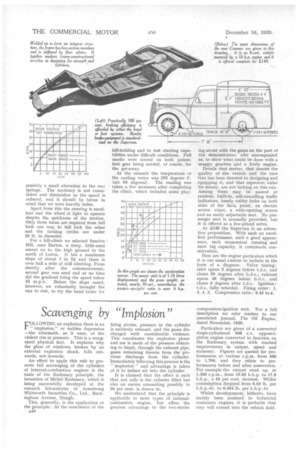Scavenging by
Page 42

If you've noticed an error in this article please click here to report it so we can fix it.
"Implosion" VOLLOWING an explosion there is an
" implosion," or sudden depression —the aftermath, as it were, of the violent rise in pressure. This is a recognized physical fact. It explains why the glass of windows, broken 'by an external explosion shock, falls outwards, not inwards.
An effort to apply this rule to promote full scavenging of the cylinders of internal-combustion engines is the basis of the Kadenacy principle, the invention of Michel Kadenacy, which is being successfully developed at the research laboratories of Armstronr, Whitworth Securities Co., Ltd., Buc ingham Avenue, Slough.
This, generally, is the application of the principle: At the conclusion of the A40 firing stroke, pressure in the cylinder is suddenly released, and the gases discharged with considerable violence. This constitutes the explosion phase and use is made of the pressure obtaining to impel, through the exhaust pipe, gases remaining therein from the previous discharge from the cylinder. Immediately following this process is the " implosion" and advantage is taken of it to induce air into the cylinder.
It is claimed that the effect is such that not only is the cylinder filled but also an excess amounting possibly to 50 per cent, is drawn in.
We understand that the principle is applicable to most types of internalcombustior. engine, but offers the greatest advantage to the two-stroke
compression-ignition unit. For a full description we refer readers to our associated journal, The Oil Engine, dated November, 1999.
Particulars are given of a converted single-cylindered 698 c.c. opposedpiston engine converted to function on the Kadenacy system with marked improvement in output, speed and economy. Figures are quoted for performances at various r.p.m. from 500 to 1,700, and they relate to performances before and after conversion. For example the output went up, at 1,200 r.p.m., from 10.85 b.h.p. to 17.8 b.h.p., a 55 per cent. increase. Whilst consumption dropped from 0.53 lb. per b.h.p.-hr. to 0.364 lb. per b.h.p.-hr.
Whilst developments, hitherto, have mainly been Gonfined to industrial stationary engines, it is probable that they will extend into the vehicle field.




































































